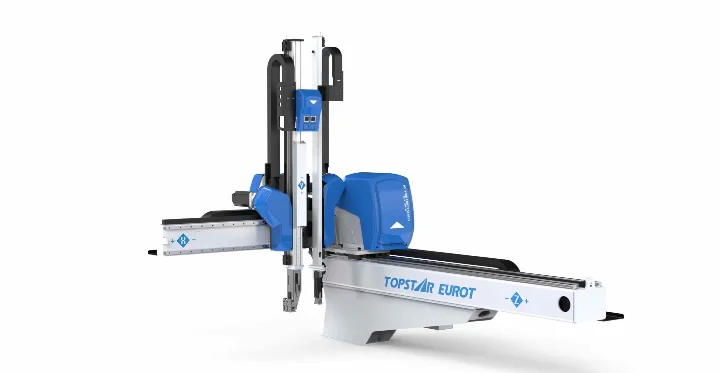Explore the transformative role of injection robots in revolutionizing the Injection Molding industry. Dive into their functionalities and applications, from Cartesian to SCARA robots. Discover how vision systems augment precision and quality assurance and explore the future trends shaping robotic integration. Gain insights into optimizing efficiency and navigating challenges, ensuring your firm stays ahead in this dynamic landscape of innovation.
In this article, we will explore the different types, functions, and applications of injection robots. And unravel the intricacies of their role in optimizing the efficiency and accuracy of the Injection Molding process.
The Robotic Arsenal: Diverse Types of Injection Molding Robots
To know about injection robots, we need to look at different robots made for injection molding.
This part explains different kinds of injection robots. There are Cartesian robots, articulated robots, SCARA robots, collaborative robots (cobots), and other special types. Each type has its own special abilities and advantages for injection moulding.
Cartesian Robots: Precision in Linear Movements for Molding Operations
Cartesian robots are important in injection moulding because they move in straight lines on three different paths.
This part looks at how Cartesian robots are used in injection moulding. They’re really good at doing things like moving stuff around, taking out parts, and doing other straight-line movements. These actions help make injection moulding work better.
Articulated Robots: Flexibility and Adaptability in Molding Applications
Articulated robots are flexible because they have joints like human arms. They’re great for injection moulding.
This part talks about how articulated robots do hard jobs, use different moulds, and change to fit different needs.
Companies that want flexibility, versatility, and accuracy in their injection moulding can learn a lot from what articulated robots can do.
SCARA Robots: Speed and Precision in Vertical Molding Tasks
SCARA robots are really fast and accurate, especially when it comes to vertical moulding jobs.
This part talks about how SCARA robots make vertical injection moulding better, doing stuff like putting things in moulds, covering them with more material, and moving parts up and down.
If companies want to be faster and more precise when moulding things vertically, they can use SCARA robots.
Collaborative Robots (Cobots): A New Era of Human-Robot Collaboration
Collaborative robots, or cobots, are changing how injection moulding works by helping people and robots work together.
This part talks about how cobots are used in injection moulding places. It focuses on jobs that need skill, human supervision, and working closely together.
Find out how cobots make injection moulding places safer, faster, and more teamwork-oriented.
Vision Systems and Sensors: Augmenting Precision and Quality Assurance
In Injection Molding, vision systems and sensors are important. They help with quality control, finding defects, and placing parts accurately.
Manufacturers who want precise, high-quality products can examine how vision systems and sensors work with robots to improve their products.
Programming and Control: The Brain Behind Robotic Precision
The smartness of robots comes from their programming and control systems. This part explains how to program robots for Injection Molding jobs and talks about how control systems help them work smoothly together.
Companies and engineers can learn how to make robots work better by focusing on their programming and control.
Advantages and Challenges of Injection Robots in Molding Applications
Using injection robots in injection moulding has many advantages, but it also has some challenges. This part gives a fair view, showing how robots can make things better by making the process faster, more accurate, and cheaper.
There are also problems, like the cost of starting up, the complexity of programming the robots, and the need for workers to be trained to use them properly.
Future Trends and Innovations: Shaping the Landscape of Robotic Injection Molding
As technology gets better, this part talks about what might happen next with robots in Injection Molding.
This includes things like using artificial intelligence (AI) and better teamwork between robots.
It helps manufacturers see what’s coming and get ready for new tech that will change Injection Molding.
To summarize
Injection robots made specifically for Injection Molding machines are very important in making the Injection Molding process better and more modern.
This research shows different kinds of injection robots, what they do, and how important they are for different parts of moulding work.
As the Injection Molding industry uses more automation, companies can use this information to decide how to use injection robots. This helps them stay ahead in making things better and faster in this changing industry.
FAQs for Injection Molding:
Q1: What is injection molding?
A1: Injection moulding is a way to make stuff. You melt plastic and push it into a mould really hard. After it cools down, you get plastic things in the shape of a mould.
Q2: What materials can be used in injection moulding?
A2: Injection moulding is often used with plastics like polyethene, polystyrene, and polypropylene, but it can also be used with other types of plastics and rubbery materials.
Q3: What are the advantages of injection moulding?
A3: Injection moulding is really good for making lots of things quickly and accurately. It lets you make complicated shapes and sizes just right. It’s also good for making a lot of things at once without spending too much money, and you can design lots of different things with it.
Q4: What industries use injection moulding?
A4: Injection moulding is utilized in various industries, including automotive, electronics, medical devices, consumer goods, and packaging, due to its versatility and efficiency in producing plastic components.
Q5: How does the injection moulding process work?
A5: The process involves melting plastic pellets, injecting the molten material into a mould, cooling it to solidify, and then ejecting the finished part from the mould cavity.
Q6: What factors affect the quality of injection moulded parts?
A6: Factors influencing part quality include mould design, material selection, processing parameters, injection pressure, temperature control, and mould cooling. Proper optimization of these factors is crucial for achieving desired results in injection moulding.

